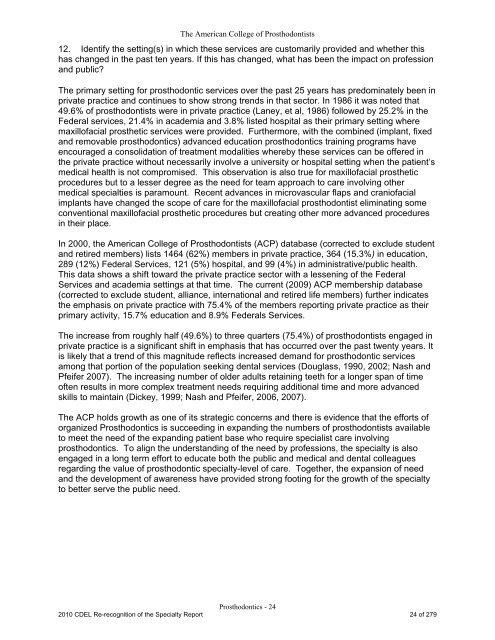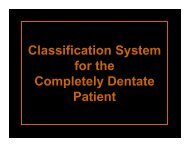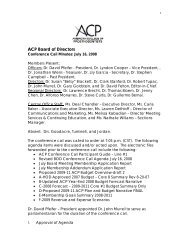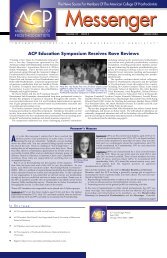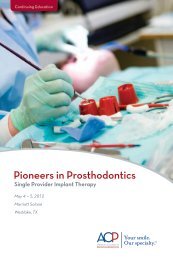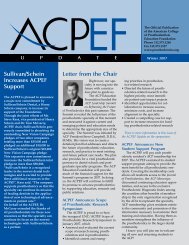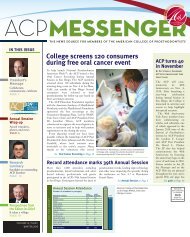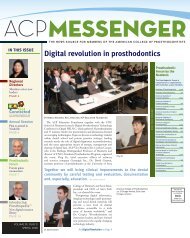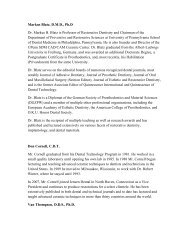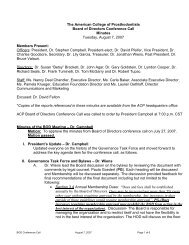PROSTHODONTICS - American College of Prosthodontists
PROSTHODONTICS - American College of Prosthodontists
PROSTHODONTICS - American College of Prosthodontists
You also want an ePaper? Increase the reach of your titles
YUMPU automatically turns print PDFs into web optimized ePapers that Google loves.
The <strong>American</strong> <strong>College</strong> <strong>of</strong> <strong>Prosthodontists</strong>12. Identify the setting(s) in which these services are customarily provided and whether thishas changed in the past ten years. If this has changed, what has been the impact on pr<strong>of</strong>essionand public?The primary setting for prosthodontic services over the past 25 years has predominately been inprivate practice and continues to show strong trends in that sector. In 1986 it was noted that49.6% <strong>of</strong> prosthodontists were in private practice (Laney, et al, 1986) followed by 25.2% in theFederal services, 21.4% in academia and 3.8% listed hospital as their primary setting wheremaxill<strong>of</strong>acial prosthetic services were provided. Furthermore, with the combined (implant, fixedand removable prosthodontics) advanced education prosthodontics training programs haveencouraged a consolidation <strong>of</strong> treatment modalities whereby these services can be <strong>of</strong>fered inthe private practice without necessarily involve a university or hospital setting when the patient’smedical health is not compromised. This observation is also true for maxill<strong>of</strong>acial prostheticprocedures but to a lesser degree as the need for team approach to care involving othermedical specialties is paramount. Recent advances in microvascular flaps and crani<strong>of</strong>acialimplants have changed the scope <strong>of</strong> care for the maxill<strong>of</strong>acial prosthodontist eliminating someconventional maxill<strong>of</strong>acial prosthetic procedures but creating other more advanced proceduresin their place.In 2000, the <strong>American</strong> <strong>College</strong> <strong>of</strong> <strong>Prosthodontists</strong> (ACP) database (corrected to exclude studentand retired members) lists 1464 (62%) members in private practice, 364 (15.3%) in education,289 (12%) Federal Services, 121 (5%) hospital, and 99 (4%) in administrative/public health.This data shows a shift toward the private practice sector with a lessening <strong>of</strong> the FederalServices and academia settings at that time. The current (2009) ACP membership database(corrected to exclude student, alliance, international and retired life members) further indicatesthe emphasis on private practice with 75.4% <strong>of</strong> the members reporting private practice as theirprimary activity, 15.7% education and 8.9% Federals Services.The increase from roughly half (49.6%) to three quarters (75.4%) <strong>of</strong> prosthodontists engaged inprivate practice is a significant shift in emphasis that has occurred over the past twenty years. Itis likely that a trend <strong>of</strong> this magnitude reflects increased demand for prosthodontic servicesamong that portion <strong>of</strong> the population seeking dental services (Douglass, 1990, 2002; Nash andPfeifer 2007). The increasing number <strong>of</strong> older adults retaining teeth for a longer span <strong>of</strong> time<strong>of</strong>ten results in more complex treatment needs requiring additional time and more advancedskills to maintain (Dickey, 1999; Nash and Pfeifer, 2006, 2007).The ACP holds growth as one <strong>of</strong> its strategic concerns and there is evidence that the efforts <strong>of</strong>organized Prosthodontics is succeeding in expanding the numbers <strong>of</strong> prosthodontists availableto meet the need <strong>of</strong> the expanding patient base who require specialist care involvingprosthodontics. To align the understanding <strong>of</strong> the need by pr<strong>of</strong>essions, the specialty is alsoengaged in a long term effort to educate both the public and medical and dental colleaguesregarding the value <strong>of</strong> prosthodontic specialty-level <strong>of</strong> care. Together, the expansion <strong>of</strong> needand the development <strong>of</strong> awareness have provided strong footing for the growth <strong>of</strong> the specialtyto better serve the public need.Prosthodontics - 242010 CDEL Re-recognition <strong>of</strong> the Specialty Report 24 <strong>of</strong> 279


